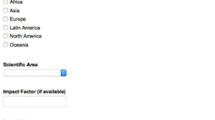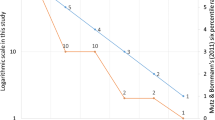Abstract
This paper examines the genesis of journal impact measures and how their evolution culminated in the journal impact factor (JIF) produced by the Institute for Scientific Information. The paper shows how the various building blocks of the dominant JIF (published in the Journal Citation Report - JCR) came into being. The paper argues that these building blocks were all constructed fairly arbitrarily or for different purposes than those that govern the contemporary use of the JIF. The results are a faulty method, widely open to manipulation by journal editors and misuse by uncritical parties. The discussion examines some solution offered to the bibliometrics and scientific communities considering the wide use of this indicator at present.
Similar content being viewed by others
References
Allen, E. S. (1929), Periodicals for mathematicians. Science, 70(1825): 592–594.
Brodman, E. (1944), Choosing physiology journals. Bull Med Libr Assoc, 32(4): 479–483.
Bensman, S. J. (2007), Garfield and the impact factor. Annual Review of Information Science and Technology, 41: 93–155.
Brown, C. H. (1956), Scientific serials: characteristics and lists of most cited publications in mathematics, physics, chemistry, geology, physiology, botany, zoology, and entomology. ACRL Monograph no. 16. Chicago: Association of College and Research Libraries.
Cunningham, E. R. (1935), The present status of the publication of literature in the medical and biological sciences. Bull Med Libr Assoc., 24(1): 64–81.
Fassoulaki, A., Papilas K., Paraskeva A., Patris K (2002), Impact factor bias and proposed adjustments for its determination. Acta Anaesthesiologica Scandinavica, 46(7): 902–905.
Fuyuno, I., Cyranoski, D. (2006), Cash for papers: Putting a premium on publication. Nature, 441(7095): 792.
Garfield, E. (1955), Citation indexes for science. Science, 122(3159): 108–111.
Garfield, E. (1972), Citation analysis as a tool in journal evaluation. Science, 178(4060): 471–479.
Garfield, E. (2006), The history and meaning of the journal impact factor. JAMA - Journal of the American Medical Association, 295(1): 90–93.
Garfield, E., Sher, I. H. (1963A), Genetics Citation Index. Philadelphia: Institute for Scientific Information.
Garfield, E., Sher, I. H. (1963B), New factors in evaluation of scientific literature through citation indexing. American Documentation, 14(3): 195–201.
Glänzel, W., Moed, H. F. (2002), Journal impact measures in bibliometric research. Scientometrics, 53(2): 171–193.
Gregory, J. (1937), An evaluation of medical periodicals. Bull Med Libr Assoc., 25(3): 172–188.
Gross, P. L. K., Gross, E. M. (1927), College libraries and chemical education. Science, 66(1713): 385–389.
Gross, P. L. K., Woodford, A. O. (1931), Serial literature used by American geologists. Science, 73(1903): 660–664.
Hackh, I. (1936), The periodicals useful in the dental library. Bull Med Libr Assoc., 25(1–2) : 109–112.
Henkle, H. H. (1938), The periodical literature of biochemistry. Bull Med Libr Assoc., 27(2): 139–147.
Huth, E. J. (2001), Authors, editors, policy makers, and the impact factor. Croatian Medical Journal, 42(1): 14–17.
Lindsey, D. (1989), Using citation counts as a measure of quality in science: measuring what’s measurable rather than what’s valid. Scientometrics, 15(3–4): 189–203.
Martyn, J., Gilchrist, A. (1968), An Evaluation of British Scientific Journals (1 ed.): Aslib.
McNeely, J. K., Crosno, C. D. (1930), Periodicals for electrical engineers. Science, 72(1856): 81–84.
Moed, H. F., Van Leeuwen, T. N. (1995), Improving the accuracy of Institute for Scientific Informations journal impact factors. Journal of the American Society for Information Science, 46(6): 461–467.
Opthof, T. (1997), Sense and nonsense about the impact factor. Cardiovascular Research, 33(1): 1–7.
Pudovkin, A. I., Garfield, E. (2004), Rank-normalized impact factor: A way to compare journal performance across subject categories. Proceedings of the 67th ASIS&T Annual Meeting, 41: 507–515.
Raisig, L. M. (1960), Mathematical evaluation of the scientific serial. Science, 131(3411): 1417–1419.
Ramirez, A. M., Garcia, E. O., Del Rio, J. A. (2000), Renormalized impact factor. Scientometrics, 47(1): 3–9.
Schubert, A., Braun, T. (1996), Cross-field normalization of scientometric indicators. Scientometrics, 36(3): 311–324.
Schwartz, S., Hellin, J. L. (1996), Measuring the impact of scientific publications. The case of the biomedical sciences. Scientometrics, 35(1): 119–132
Sen, B. K., Shailendra, K. (1992), Evaluation of recent scientific research output by a bibliometric method. Scientometrics, 23(1): 31–46.
Seglen, P. O. (1992), The skewness of science. Journal of the American Society for Information Science, 43(9): 628–638.
Seglen, P. O. (1997), Why the impact factor of journals should not be used for evaluating research. British Medical Journal, 314: 497.
Smith, R. (1997), Journal accused of manipulating impact factor. British Medical Journal, 314(7079): 463.
Sombatsompop, N., Markpin, T., Yochai, W., Saechiew, M. (2005), An evaluation of research performance for different subject categories using Impact Factor Point Average (IFPA) index: Thailand case study. Scientometrics, 65(3): 293–305.
Van Leeuwen, T. N., Moed, H. F. (2001), Development and application of new journal impact measures. Cortex, 37(4): 607–610.
Westbrook, J. H. (1960), Identifying Significant Research. Science, 132(3435): 1229–1234.
Zipf, G. K. (1949), Human Behavior and the Principle of Least Effort. Cambridge, Ma.: Addison-Wesley.
Author information
Authors and Affiliations
Corresponding author
Rights and permissions
About this article
Cite this article
Archambault, É., Larivière, V. History of the journal impact factor: Contingencies and consequences. Scientometrics 79, 635–649 (2009). https://doi.org/10.1007/s11192-007-2036-x
Received:
Published:
Issue Date:
DOI: https://doi.org/10.1007/s11192-007-2036-x




